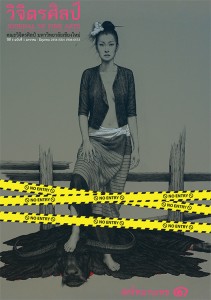การศึกษาพระพุทธรูปทรงเครื่องศิลปะพม่า วัดม่อนปู่ยักษ์ เมืองลำปาง
Main Article Content
Abstract
ปัจจุบัน และสัญลักษณ์จากวัสดุที่ใช้ในการสร้าง โดยเฉพาะคติความเชื่อเรื่องอานิสงส์การสร้างพระพุทธรูปด้วยเกสรดอกไม้เพื่อถวายเป็นพุทธบูชาและสืบทอดพระพุทธศาสนา ด้วยกรรมวิธีการสร้างงานศิลปะเครื่องเขิน ซึ่งเป็นลักษณะพิเศษในงานพุทธศิลป์ของพม่าและไทใหญ่ สันนิษฐานว่าสร้างขึ้นจากประเทศพม่าแล้วอัญเชิญมาประดิษฐานในวิหารไม้วัดม่อนปู่ยักษ์เมื่อประมาณ 150 ปีก่อน
ส่วนการอนุรักษ์พระพุทธรูปที่ชำรุดให้กลับมามีสภาพที่มั่นคงแข็งแรงนั้นได้ทำการตรวจสอบองค์ประกอบและคุณสมบัติของวัสดุที่ใช้ในการสร้างพระพุทธรูปด้วยกล้องจุลทรรศน์อิเล็กตรอน รวมทั้งปฏิบัติการอนุรักษ์โดยใช้ความรู้ด้านเทคนิคและกระบวนการอนุรักษ์งานศิลปกรรมประกอบกับความรู้จากการศึกษาวิจัย นอกจากนี้ ผู้วิจัยได้สร้างพระพุทธปฏิมาองค์จำลองโดยนำองค์ความรู้จากการศึกษาวิจัยเบื้องต้นมาเป็นแนวทาง ด้วยแนวคิด รูปแบบเทคนิควิธีการที่สะท้อนถึงคติความเชื่อและภูมิปัญญาท้องถิ่น ผสมผสานกับความรู้ทางด้านทัศนศิลป์ในปัจจุบัน ทั้งนี้ หัวใจสำคัญของผลการศึกษาวิจัยครั้งนี้ คือ องค์พระพุทธรูปได้กลับมามีสภาพที่มั่นคงแข็งแรงและเกิดองค์ความรู้เรื่องการอนุรักษ์พระพุทธรูปศิลปะพม่าในล้านนา ตลอดจนสร้างความภาคภูมิใจแก่ผ้คู นในชุมชนท้องถิ่น เพื่อเป็นการอนุรักษ์และสืบทอดมรดกทางวัฒนธรรมของชาติอย่างยั่งยืน
A Study Buddha Image Burma Arts at Wat Monpooyak, Lampang Province for Conservation and Arts Creation.
This research had the purposes of studying the history, concept for and techniques involved in the creation of the Buddhist image of the Burmese art at Wat Monpooyak in Lampang Province and conducting the conservation of the damaged image utilizing the knowledge of art and scientific conservation methods as well as creating a duplicate model of the mage based on the knowledge gained from the research whose concept, form and technique reflected the local wisdom. The researcher found that the Buddha image of the Burmese art of the Mandalay School at Wat Monpooyak in Lampang Province was of the preaching to Jambupati posture influenced by the iconography of the Tai Yai school of Buddha sculpture which conveyed the symbolic meaning of the characteristics of a great man, the Buddha, and the materials used in the casting, in particular the belief in the merit of creating a Buddha image from flower pollen to pay respect to the Buddha and to propagate or pass down Buddhism. The method used was that of the lacquer-ware making art unique to the Burmese and Tai Yai approximately 150 years ago.
In the conservation of the image to make it strong and sturdy, the knowledge and technique of the art and science of conservation were combined. An electron microscope was used to examine its components and material properties. Knowledge was drawn from experience in art conservation practice and technique. Furthermore, the researcher also created a duplicate model of the image applying the knowledge gained from the primary research in terms of concept, form technique and method that reflect the local beliefs and wisdom in combination with the modern knowledge of visual art. The key part of this research was that the Buddha image had been restored to a strong and solid condition along with the knowledge of the Burmese style Buddha image in Lan Na while stimulating pride among the members of the cultural community and conserving and sustaining the nation’s cultural heritage for a long lasting existence.


